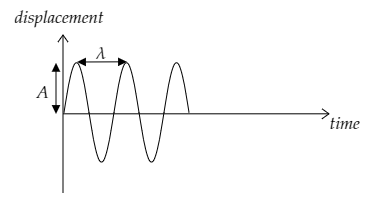
A sine wave has an amplitude $A$ and wavelength $\lambda $. Let $V$ be the wave velocity and $v$ be the maximum velocity of a particle in the medium. Which of the following options is correct?
A) $V$ cannot be equal to $v$
B) $V = v$, if $A = 12\pi \lambda $
C) $V = v$, if $A = 2\pi \lambda $
D) $V = v$, if $\lambda = \dfrac{A}{\pi }$
E) $V = v$, if $A = \dfrac{\lambda }{{2\pi }}$
Answer
544.5k+ views
Hint: When the velocity of the particle in the medium is maximum, that velocity will be equal to the product of the amplitude of the wave and the angular frequency of the wave. The velocity of the wave is expressed in terms of its frequency and wavelength. Equating the two relations should provide us with the necessary value of the amplitude of the wave.
Formula used: The velocity of the wave is given by, $v = f\lambda $ where $f$ is the frequency of the wave and $\lambda $ is the wavelength of the wave.
The angular frequency of a wave is given by, $\omega = 2\pi f$ where $f$ is the frequency of the wave.
Complete step-by-step answer:
Step 1: List the parameters of the given wave.
The given wave is a sine wave whose amplitude is $A$ and wavelength is $\lambda $ as shown in the figure below.

Let $f$ be the frequency and $\omega $ be the angular frequency of the given sine wave.
The velocity of the wave is also mentioned to be $V$ whereas the maximum velocity of the particle in the medium of propagation is mentioned to be $v$ .
Step 2: Express the relation for the velocity of the wave and the maximum velocity of the particle in the medium.
For the given maximum velocity $v$ of the particle in the medium, we have $v = A\omega $ ------- (1)
Now the velocity of the wave can be expressed as $V = f\lambda $ --------- (2)
Let the two velocities be equal i.e., $v = V$ ---------- (3)
Substituting equations (1) and (2) in (3) we get, $A\omega = f\lambda $ but as $\omega = 2\pi f$ we have $A2\pi f = f\lambda $
$ \Rightarrow 2\pi A = \lambda $ or $A = \dfrac{\lambda }{{2\pi }}$ .
Thus $v = V$ only if $A = \dfrac{\lambda }{{2\pi }}$ .
So the correct option is E.
Note: Here to obtain the relation for the amplitude of the wave for which the velocity of the wave and the maximum velocity of the particle in the medium of propagation are equal, we have to assume that the two velocities are equal. Only then can we derive the necessary relation. For a sine wave, the frequency of the wave and its wavelength are inversely proportional to each other.
Formula used: The velocity of the wave is given by, $v = f\lambda $ where $f$ is the frequency of the wave and $\lambda $ is the wavelength of the wave.
The angular frequency of a wave is given by, $\omega = 2\pi f$ where $f$ is the frequency of the wave.
Complete step-by-step answer:
Step 1: List the parameters of the given wave.
The given wave is a sine wave whose amplitude is $A$ and wavelength is $\lambda $ as shown in the figure below.

Let $f$ be the frequency and $\omega $ be the angular frequency of the given sine wave.
The velocity of the wave is also mentioned to be $V$ whereas the maximum velocity of the particle in the medium of propagation is mentioned to be $v$ .
Step 2: Express the relation for the velocity of the wave and the maximum velocity of the particle in the medium.
For the given maximum velocity $v$ of the particle in the medium, we have $v = A\omega $ ------- (1)
Now the velocity of the wave can be expressed as $V = f\lambda $ --------- (2)
Let the two velocities be equal i.e., $v = V$ ---------- (3)
Substituting equations (1) and (2) in (3) we get, $A\omega = f\lambda $ but as $\omega = 2\pi f$ we have $A2\pi f = f\lambda $
$ \Rightarrow 2\pi A = \lambda $ or $A = \dfrac{\lambda }{{2\pi }}$ .
Thus $v = V$ only if $A = \dfrac{\lambda }{{2\pi }}$ .
So the correct option is E.
Note: Here to obtain the relation for the amplitude of the wave for which the velocity of the wave and the maximum velocity of the particle in the medium of propagation are equal, we have to assume that the two velocities are equal. Only then can we derive the necessary relation. For a sine wave, the frequency of the wave and its wavelength are inversely proportional to each other.
Recently Updated Pages
How do you convert r6sec theta into Cartesian form class 10 maths CBSE

How do you solve dfrac5y3dfracy+72y6+1 and find any class 10 maths CBSE

If sin A+B1 and cos AB1 0circ le left A+B rightle 90circ class 10 maths CBSE

On the number line 10 is to the of zero class 10 maths CBSE

How do you solve 5xge 30 class 10 maths CBSE

In the following sentence supply a verb in agreement class 10 english CBSE

Trending doubts
Write an application to the principal requesting five class 10 english CBSE

Why is there a time difference of about 5 hours between class 10 social science CBSE

Write a letter to the principal requesting him to grant class 10 english CBSE

The Equation xxx + 2 is Satisfied when x is Equal to Class 10 Maths

What is the median of the first 10 natural numbers class 10 maths CBSE

Write examples of herbivores carnivores and omnivo class 10 biology CBSE




